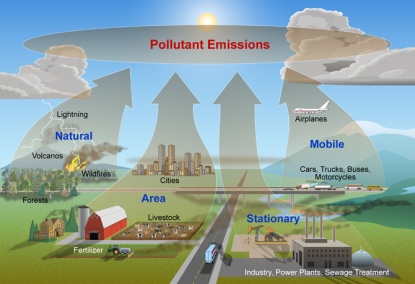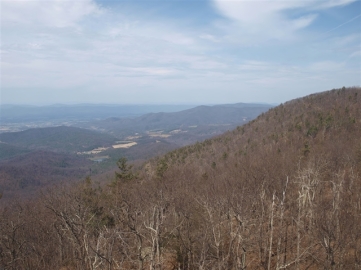By: Mike Marsh
Haze pollution at Shenandoah National Park is reaching excessive levels and the air pollution is presenting hazardous environmental conditions for the surrounding area.
Fossil-fuel power plants and industrial facilities affecting the Shenandoah are primarily located in the mid-West and the mid-Atlantic regions, particularly from West Virginia, Virginia, Ohio, Pennsylvania and Kentucky have air pollution traveling hundreds of miles to reach parks like Shenandoah. Alarmingly, Shenandoah National Park is now rated the second most polluted park in the nation and residents of neighboring counties want to how that air quality is affecting them.
A National Parks Conservation Association report, which ranked Shenandoah the second most polluted nation park in the nation states that “visibility from Skyline Drive and the Appalachian Trail had shrunk to as little as one mile on smoggy summer days, although visibility at the park had improved slightly on the least-polluted days.”
The report also notes that instead of seeing the typical range of 115 miles, the average visibility is now down to 15 miles and also confirmed that ozone from the pollution was hurting vegetation and wildlife in the surrounding areas.
They claim the main sources of the air pollution were fossil-fuel power plants, industrial facilities and motor vehicle emissions. Another eye-popping statistic from the National Parks Conservation report was that the pollution coming from states like West Virginia “accounts for 60 to 80 percent of the visibility impairment in the eastern parks.”
This is an infographic released by the National Park Service that depicts the different ways haze pollution (natural, area, mobile, and stationary sources) can form and where they come from:
According to the Environmental Protection Agency mobile sources account for more than half of all the air pollution in the United States. They also note that stationary sources, like power plants, emit large amounts of pollution from a single location that are also known as major sources of park pollution. The natural and area sources aren’t known to be that much of a problem compared to mobile and stationary sources, but they can still contribute to air pollution.
The National Park Service has a live streaming webcam where you can monitor the haze and see real time streaming webcams of the haze levels at Shenandoah National Park.
Here is a view of the haze and visibility from the park’s webcam from this afternoon. It is easy to see the haze levels in the distance lingering over the valley:
The National Park Service categorizes the effects of air pollution and haze levels in national parks into four main categories: Visibility, Human Health, Ecological, and Economic.
Visibility:
The NPS says air pollution can create a white or brown haze that affects how far we can see and also affects how well we are able to see the colors, texture and forms of the landscape. Haze is a product of air pollutants, such as fine particles in the air that absorb and scatter sunlight, making it hard to see far distances. Haze is mostly caused by air pollution from industry and motor vehicles.
This is an example from the NPS that shows how air pollution can effect visibility:
Human Health:
The NPS recorded ozone concentrations and fine particulate concentrations have approached and exceeded the national health standards at several NPS areas including Shenandoah. Particle exposure has one of the most dramatic effects on humans and can lead to a variety of health effects according to the NPS.
Long-term exposures, such as those experienced by people living for many years in areas with high particle levels, contribute to reduced lung function and the development of chronic bronchitis and even premature death. Short-term exposures to particles (hours or days) can aggravate lung disease, causing asthma attacks and acute bronchitis, and may also increase susceptibility to respiratory infections. In people with heart disease, short-term exposures have been linked to heart attacks.
Other hazardous health effects from haze are caused from ozone, toxins and mercury, and sulfur dioxide pollutants.
Ecological:
The NPS claims that air pollutants can harm ecological resources, including water quality, soils, plants, and animals. Ozone is known to cause damage to plant tissues and reduced growth in some sensitive plant species. Nitrogen and sulfur in air pollution are carried by rain, snow, and fog into park ecosystems where they threaten sensitive aquatic and terrestrial resources.
It is also noted by the NPS that metals (mercury) and toxic compounds (pesticides) can be deposited from the atmosphere and threaten the food chain. This can cause behavioral, neurological, and reproductive effects in fish, birds, and wildlife.
Economic:
The NPS says they have conducted multiple studies have shown that people place an economic value on, or a “willingness to pay” for improvements in visibility where they live. This can impact the value of land around high-air-pollution areas like Shenandoah in Virginia.
The NPS claims that economic benefits from visitation is very dependent upon protection of park natural resources like air quality. Visitor spending in communities surrounding national park sites was estimated at 11.9 billion dollars in 2009. They also report that visitor surveys consistently report that visitors consider clear air to be extremely important.



Great first post Mike! You have a lot of good information and things that make it easy to understand what you are talking about. I had no idea there was so much pollution in WV.
LikeLike
Reblogged this on digger666.
LikeLike
I really enjoyed this post, but couldn’t you have broken this post up into multiple? You talk about the specific issues, but i think you could have had 5-6 fruitful posts from this.
LikeLike
I thought it was great how you broke up each section to describe how the pollution affects different aspects, but I agree with Joe that there was definitely a possibility of turning this into another post or two considering all of the content here. Nevertheless, it was still well researched and provided the real issues that are facing these areas with air pollution. I would be interest to hear what they plan on doing in the future to help bring this problem down.
LikeLike